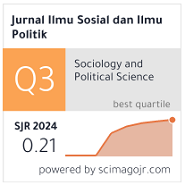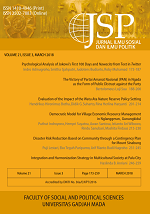Bridging Indonesia’s Digital Divide: Rural-Urban Linkages?
Aulia Hadi(1*)
(1) Research Center for Society and Culture, Indonesian Institute of Sciences
(*) Corresponding Author
Abstract
Keywords
Full Text:
PDFReferences
Acilar, A. (2011). Exploring the Aspects of Digital Divide in a Developing Country. Issues in Informing Science and Information Technology, 8, 231-244.
Azali, K. (2017). Indonesia’s divided digital economy (pp. 1-12, Working paper ISEAS Perspective No. 70). Singapore: Yusof Ishak Institute. Cerita Duta Petani Muda 2016: Rici Solihin “Paprici” Petani Paprika Masa Kini. (n.d.). Retrieved from http://petanimuda.org/ cerita-duta-petani-muda-2016-rici-solihin- petani-paprika/.
Chen, W. & Wellman, B. (2004). The Global Digital Divide-Within and B etw een Countries. IT & Society, 1(7), 18-25.
Douglass, M. (1998). A Regional network strategy for reciprocal rural-urban linkages: an agenda for policy research with reference to Indonesia. Third World Planning Review, 20 (1), 1-35. doi : 10.3828/twpr.20.1. f2827602h503k5j6.
Dvorghets, O. S. & Shaturnaya, Y.A. (2015). Developing students’ media literacy in the English language teaching context. Procedia- Social and Behavioral Sciences 200, 192-198.
Furuholt, B & Kristiansen, S. (2007, May). A Rural-urban digital divide? regional aspects of internet use in Tanzania. Proceedings of the 9th International Conference on Social Implications of Computers in Developing Countries. São Paulo, Brazil. Retrieved from http://docshare01.docshare.tips/ files/9317/93174281.pdf.
Gunkel, D. J. (2003). Second thoughts: toward a critique of the digital divide. New Media and Society, 5(4), 499-522.
Kouritzin, S. G. (2000). Bringing life to research: life history research and ESL. TESL Canada Journal/Revue TESL Du Canada, 17(2), 1-35.
Mashari, I. (2016). Telemetry over GPRS for VICO Indonesia. Retreived from https://www.slideshare.net/busgoz/telemetry- over-gprs-vico-indonesia.
MCIT. (2016). Households & individual ICT indicators. Jakarta: R&D Center for Post & ICT Resources, Equipment & Operation, Research, and Development of Human Resources, Ministry of Communication and Information Technology.
Nair, M., Soo Han, G., Lee H., Goon, P., & Muda, R. (2010). Determinants of the digital divide in rural communities of a developing country: the case of Malaysia. Development and Society, 39(1), 139-162.
Norris, P. (2001). Digital divide: Civic engagement, information poverty, and the internet worldwide. Cambridge: Cambridge University Press.
Oreglia, E. (2013). From farm to farmville: circulation, adoption, and use of ICT between urban and rural China (Unpublished doctoral dissertation). Berkeley: University of California.
Poerwaningtias, I., & Rianto, P. (2013). Model- model gerakan literasi media dan pemantauan media di Indonesia. Yogyakarta: Pusat Kajian Media dan Budaya Populer (PKMBP) cooperating with Yayasan Tifa.
Purbo, O. W. (2017). Narrowing the digital divide. In E. Jurriëns & R. Tapsell (Eds.). Digital Indonesia: Connectivity and Divergence (pp. 75-92). Singapore: ISEAS Publishing.
Rinoza, R. (2015). Persoalan Kesenjangan Digital di Indonesia. October 8. Retrieved from http://www.remotivi.or.id/amatan/222/ P ersoalan-Kesenjangan-Digital-di- Indonesia.
Selwyn, N. (2004). Reconsidering political and popular understandings of the digital divide. New Media and Society, 6(3), 341-362. doi: 10.1177/146144480402519.
Servon, L. J. (2002). Bridging the digital divide: technology, community, and public policy. Malden, Oxford, Victoria, Berlin: Blackwell Publishing.
Singh, S. (2010). Digital divide in India: measurement, determinants, and policy for addressing the challenges in bridging the digital divide. International Journal of Innovation in the Digital Economy, 1(2), 1-24. doi: 10.4018/jide.2010040101.
St atistics Indonesia. (2010). Population Census 2010: Population age 5 years and over by area and educational attainment Pandeglang Regency. Retrieved from http://sp2010.bps.go.id/index.php/site/ tabel?search-tabel=Penduduk+Berumur+5 +Tahun+Keatas+Menurut+Wilayah+dan+Pendidikan+Tertinggi+yang+Ditamatkan&tid=328&searchwilayah=Kabupaten+Pand eglang&wid=3601000000&lang=id.
Subiakto, H. (2013). Internet untuk Pedesaan dan Pemanfaatannya bagi Masyarakat. Masyarakat, Kebudayaan dan Politik, 26(4), 243-256.
van Dijk, J.A.G.M. (2005). The deepening divide, inequality in the information society. Thousand Oaks, CA, London, New Delhi: Sage.
van Dijk, J.A.G.M. (2012a). The network society 3rd edition. London, Thousands Oak, New Delhi, Singapore: Sage Publications.
van Dijk, J.A.G.M. (2012b). The evolution of the digital divide: The digital divide turns into inequality of skills and usage. In J. Bus, M. Crompton, M. Hildebrandt, G. Metakides (Eds.). Digital Enlightenment Yearbook 2012(pp. 57-75). Amsterdam: IOS Press.
Wahyuningtyas, N., & Adi, K. R. (2016). Digital Divide Perempuan Indonesia. Sejarah dan Budaya, 10(1), 80-88.
Warschauer, M. (2003). Technology and social inclusion: rethinking the digital divide . Cambridge & Massachusetts: the MIT Press.
Woodward, I. (2007). Understanding material culture. Los Angeles, London, New Delhi, Singapore: Sage Publications.
Yuliastuti, D. (2016). Ini dia tiga duta petani muda indonesia 2016. Retrieved from https://bisnis.tempo.co/read/821906/ini- dia-tiga-duta-petani-muda-indonesia-2016.
Article Metrics
Refbacks
- There are currently no refbacks.
Copyright (c) 2018 Jurnal Ilmu Sosial dan Ilmu Politik

This work is licensed under a Creative Commons Attribution-NonCommercial-NoDerivatives 4.0 International License.






















